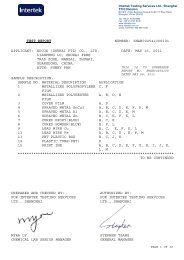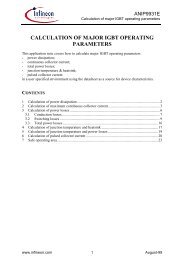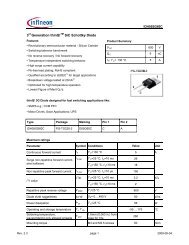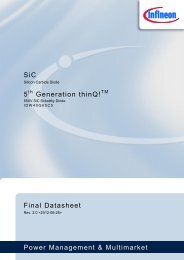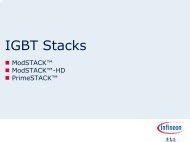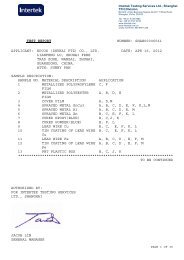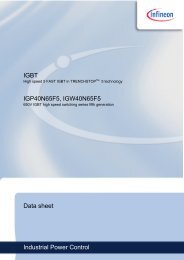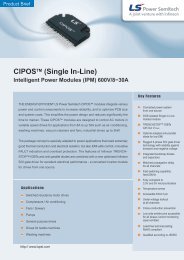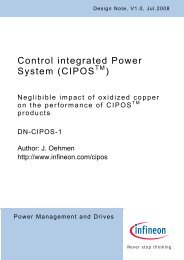You also want an ePaper? Increase the reach of your titles
YUMPU automatically turns print PDFs into web optimized ePapers that Google loves.
Application Note , Oct.2010<br />
Control Integrated POwer<br />
System (CIPOS TM )<br />
R e f e r e n c e B o a r d f o r I G C M x x F 6 0 G A<br />
w i t h 3 - s h u n t<br />
AN-CIPOS <strong>mini</strong>-2-Reference Board-3<br />
Authors: JunHo Lee, JunBae Lee and DaeWoong Chung<br />
http://www.lspst.com<br />
F o r P o w e r M a n a g e m e n t<br />
A p p l i c a t i o n
Revision History: V1.0<br />
Previous Version:<br />
Page<br />
Subjects (major changes since last revision)<br />
Edition 2010-10<br />
Published by<br />
LS Power Semitech Co., Ltd.<br />
Seoul, Korea<br />
© LS Power Semitech Co., Ltd.<br />
All Rights Reserved.<br />
Attention please!<br />
THE INFORMATION GIVEN IN THIS APPLICATION NOTE IS GIVEN AS A HINT FOR THE<br />
IMPLEMENTATION OF THE LS POWER SEMITECH CO., LTD. COMPONENT ONLY AND SHALL NOT<br />
BE REGARDED AS ANY DESCRIPTION OR WARRANTY OF A CERTAIN FUNCTIONALITY, CONDITION<br />
OR QUALITY OF THE LS POWER SEMITECH CO., LTD. COMPONENT. THE RECIPIENT OF THIS<br />
APPLICATION NOTE MUST VERIFY ANY FUNCTION DESCRIBED HEREIN IN THE REAL APPLICATION.<br />
LS POWER SEMITECH CO., LTD. HEREBY DISCLAIMS ANY AND ALL WARRANTIES AND LIABILITIES<br />
OF ANY KIND (INCLUDING WITHOUT LIMITATION WARRANTIES OF NON-INFRINGEMENT OF<br />
INTELLECTUAL PROPERTY RIGHTS OF ANY THIRD PARTY) WITH RESPECT TO ANY AND ALL<br />
INFORMATION GIVEN IN THIS APPLICATION NOTE.<br />
Information<br />
For further information on technology, delivery terms and conditions and prices please contact your nearest<br />
LS Power Semitech Co., Ltd. office (www.lspst.com).<br />
Warnings<br />
Due to technical requirements components may contain dangerous substances. For information on the types<br />
in question please contact your nearest LS Power Semitech Co., Ltd. office.<br />
LS Power Semitech Co., Ltd. components may only be used in life-support devices or systems with the<br />
express written approval of LS Power Semitech Co., Ltd., if a failure of such components can reasonably be<br />
expected to cause the failure of that life-support device or system, or to affect the safety or effectiveness of<br />
that device or system. Life support devices or systems are intended to be implanted in the human body, or to<br />
support and/or maintain and sustain and/or protect human life. If they fail, it is reasonable to assume that the<br />
health of the user or other persons may be endangered.
Control Integrated POwer System (CIPOS TM )<br />
Reference Board for CIPOS TM IGCMxxF60GA with 3-shunt<br />
Table of contents<br />
1 Introduction ................................................................................................................................... 4<br />
2 Schematic ...................................................................................................................................... 5<br />
3 External Connection ..................................................................................................................... 6<br />
3.1 Signal Connector (J1, 2.5mm pitch connector) ............................................................................... 6<br />
3.2 Signal Connector (J2, 2.5mm pitch connector) ............................................................................... 6<br />
3.3 Power Connector ............................................................................................................................ 6<br />
4 Key Parameters Design Guide ..................................................................................................... 7<br />
4.1 Circuit of Input Signals (LIN, HIN) ................................................................................................... 7<br />
4.2 Bootstrap Capacitor ........................................................................................................................ 7<br />
4.3 Internal Bootstrap Functionality Characteristics .............................................................................. 8<br />
4.4 Over Current Protection .................................................................................................................. 9<br />
4.4.1 Shunt Resistor Selection ................................................................................................................. 9<br />
4.4.2 Delay Time .................................................................................................................................... 10<br />
4.5 Temperature Monitor and Protection ............................................................................................ 11<br />
5 Part list ......................................................................................................................................... 12<br />
6 PCB Design Guide ...................................................................................................................... 13<br />
6.1 Layout of Reference Board ........................................................................................................... 13<br />
7 Reference ..................................................................................................................................... 14<br />
Reference Board Guide 3 Oct. 2010
Control Integrated POwer System (CIPOS TM )<br />
Reference Board for CIPOS TM IGCMxxF60GA with 3-shunt<br />
1 Introduction<br />
This reference board is composed of the IGCMxxF60GA, its <strong>mini</strong>mum peripheral components and three<br />
shunt resistors. It is designed for customers to evaluate the performance of CIPOS TM with simple connection<br />
of the control signals and power wires. Figure 1 shows the external view of reference board.<br />
This <strong>application</strong> <strong>note</strong> also describes how to design the key parameters and PCB layout.<br />
Figure 1. Reference board for IGCMxxF60GA<br />
Reference Board<br />
Power<br />
Connector<br />
CIPOS TM<br />
AC<br />
Bridge Diode<br />
Thermistor<br />
1 2 3 4 5 6 7 8 9 10 11 12 13 14<br />
VDD<br />
VFO<br />
ITRIP<br />
HIN1<br />
HIN2<br />
HIN3<br />
LIN1<br />
LIN2<br />
LIN3<br />
VSS<br />
LO3<br />
LO2<br />
LO1<br />
VB3<br />
VB2<br />
VB1<br />
HO1<br />
VS1<br />
HO2<br />
VS2<br />
HO3<br />
VS3<br />
28 27 26 25 24 23<br />
22<br />
21 20 19 18 17 16 15<br />
Power<br />
Connectors<br />
3~<br />
Power<br />
Connector<br />
Filters & Itrip, Fo & temperature<br />
monitor circuits<br />
Signal connectors to controller<br />
SMPS<br />
Controller<br />
Figure 2. Application example<br />
Reference Board Guide 4 Oct. 2010
Control Integrated POwer System (CIPOS TM )<br />
Reference Board for CIPOS TM IGCMxxF60GA with 3-shunt<br />
2 Schematic<br />
Figure 3 shows a circuitry of the reference board for IGCMxxF60GA.<br />
The reference board consists of interface circuit, bootstrap circuit, snubber capacitor, short-circuit protection,<br />
fault output circuit and three shunt resistors.<br />
CIPOS TM <strong>mini</strong><br />
NC (24)<br />
(1) VS(U)<br />
P (23)<br />
P<br />
D1<br />
R7<br />
C10<br />
C7<br />
(2) VB(U)<br />
(3) VS(V)<br />
VB1<br />
RBS1<br />
HO1<br />
VS1<br />
U (22)<br />
U<br />
D2<br />
R8<br />
C11<br />
C8<br />
(4) VB(V)<br />
(5) VS(W)<br />
VB2<br />
RBS2<br />
HO2<br />
VS2<br />
V (21)<br />
V<br />
J1<br />
(1) UH<br />
R1 ~ R6<br />
D3<br />
R9<br />
C12<br />
C9<br />
(6) VB(W)<br />
(7) HIN(U)<br />
VB3<br />
RBS3<br />
HIN1<br />
HO3<br />
VS3<br />
LO1<br />
W (20)<br />
C20<br />
W<br />
(2) VH<br />
(8) HIN(V)<br />
HIN2<br />
NU (19)<br />
R13<br />
(3) WH<br />
(4) UL<br />
(9) HIN(W)<br />
(10) LIN(U)<br />
HIN3<br />
LIN1<br />
(5) VL<br />
(6) WL<br />
(7) /Fo<br />
(9) Vctr<br />
(10) VDD<br />
(11) GND<br />
Vctr<br />
C1 ~ C6<br />
Vctr<br />
VDD<br />
C13 C14<br />
R12<br />
C19<br />
R11<br />
Vctr<br />
C15<br />
C16<br />
C18<br />
VDD<br />
C17<br />
R10<br />
(11) LIN(V)<br />
LIN2<br />
(12) LIN(W)<br />
LIN3<br />
(13) VDD<br />
VDD<br />
(14) VFO<br />
VFO<br />
(15) ITRIP<br />
ITRIP<br />
(16) VSS<br />
VSS<br />
Thermistor<br />
LO2<br />
LO3<br />
D4<br />
R17<br />
NV (18)<br />
NW (17)<br />
R14<br />
R15<br />
N<br />
J2<br />
R16<br />
D5<br />
D6<br />
R18<br />
R19<br />
(1) NU<br />
(2) NV<br />
(3) NW<br />
C20<br />
C21<br />
C22<br />
Figure 3. Circuit of the reference board<br />
Note: Vctr de<strong>note</strong>s the controller supply voltage such as 5V or 3.3V.<br />
It is optional to use external bootstrap circuit together with internal one as shown in dot line, in case<br />
that smaller bootstrap resistor is necessary.<br />
Reference Board Guide 5 Oct. 2010
Control Integrated POwer System (CIPOS TM )<br />
Reference Board for CIPOS TM IGCMxxF60GA with 3-shunt<br />
3 External Connection<br />
3.1 Signal Connector (J1, 2.5mm pitch connector)<br />
Pin Name Description<br />
1 HIN(U) High side control signal input of U phase<br />
2 HIN(V) High side control signal input of V phase<br />
3 HIN(W) Low side control signal input of W phase<br />
4 LIN(U) Low side control signal input of U phase<br />
5 LIN(V) Low side control signal input of V phase<br />
6 LIN(W) Low side control signal input of W phase<br />
7 /Fo Fault output signal / Temperature monitor<br />
8 NC No Connection<br />
9 Vctr External control voltage (5V or 3.3V)<br />
10 VDD External 15V supply voltage<br />
11 GND Ground<br />
3.2 Signal Connector (J2, 2.5mm pitch connector)<br />
Pin Name Description<br />
1 ISEN(NU) Current monitor output of NU<br />
2 ISEN(NV) Current monitor output of NV<br />
3 ISEN(NW) Current monitor output of NW<br />
3.3 Power Connector<br />
Pin<br />
U<br />
V<br />
W<br />
P<br />
N<br />
Description<br />
Output terminal of U phase<br />
Output terminal of V phase<br />
Output terminal of W phase<br />
Positive terminal of DC link voltage<br />
Negative terminal of DC link voltage<br />
Reference Board Guide 6 Oct. 2010
Control Integrated POwer System (CIPOS TM )<br />
Reference Board for CIPOS TM IGCMxxF60GA with 3-shunt<br />
4 Key Parameters Design Guide<br />
4.1 Circuit of Input Signals (LIN, HIN)<br />
The input signals can be either TTL- or CMOS-compatible. The logic levels can go down to 3.3V. The<br />
maximum input voltage of the pins is internally clamped to 10.5V. However, the recommended voltage range<br />
of input voltage is up to 5V. The control pins LIN and HIN are active high.<br />
They have an internal pull-down structure with a pull-down resistor value of nominal 5k. The input noise<br />
filter inside CIPOS TM suppresses short pulse and prevents the driven IGBT from unintentional operation. The<br />
input noise filter time (t FLIN ) is typically 270ns. This means that an input signal must stay on more than 270ns<br />
so that the input signal can be processed correctly. CIPOS TM can be connected directly to controller without<br />
external input RC filter thanks to the internal pull down resistor and input noise filter as shown in Figure 4.<br />
Controller<br />
(MCU or DSP)<br />
HINx<br />
LINx<br />
5kΩ<br />
Vz=10.5V<br />
Input<br />
Noise<br />
Filter<br />
t FILIN =270ns<br />
Figure 4. Filter of input signals and pull-down circuit<br />
4.2 Bootstrap Capacitor<br />
Bootstrapping is a common method of pumping charges from a low potential to a higher one. With this<br />
technique a supply voltage for the floating high side sections of the gate drive can be easily established<br />
according to Figure 5. It is only the effective circuit shown for one of the three half bridges. The bootstrap<br />
functionality is composed internally to limit current. Please refer to the datasheet and <strong>application</strong> <strong>note</strong> for<br />
bootstrapping method in detail.<br />
P<br />
C DD<br />
VDD<br />
Gate<br />
Drive<br />
IC<br />
VSS<br />
VB<br />
HO<br />
VS<br />
LO<br />
VBS<br />
C BS<br />
Figure 5. Bootstrap circuit for the supply of a high side gate drive<br />
Reference Board Guide 7 Oct. 2010
C BS [uF]<br />
Control Integrated POwer System (CIPOS TM )<br />
Reference Board for CIPOS TM IGCMxxF60GA with 3-shunt<br />
A low leakage current of the high side section is very important in order to keep the bootstrap capacitors<br />
small. The C BS discharges mainly by the following mechanisms:<br />
- Quiescent current to the high side circuit in the IC<br />
- Gate charge for turning high side IGBT on<br />
- Level-shift charge required by level shifters in the IC<br />
- Leakage current in the bootstrap diode<br />
- C BS capacitor leakage current (ignored for non-electrolytic capacitor)<br />
- Bootstrap diode reverse recovery charge<br />
The calculation of the bootstrap capacitor results in<br />
C<br />
BS<br />
Ileak<br />
t<br />
<br />
ΔV<br />
with I leak being the maximum discharge current of C BS , t P the maximum on pulse width of high side IGBT and<br />
V BS the voltage drop at the bootstrap capacitor within a switching period.<br />
BS<br />
P<br />
Practically, the recommended leakage current is 1mA of I leak for CIPOS TM .<br />
Figure 6 shows the curve corresponding to above equation for a continuous sinusoidal modulation, if the<br />
voltage ripple V BS is 0.1V. The recommended bootstrap capacitance for a continuous sinusoidal<br />
modulation method is therefore in the range up to 4.7µF for most switching frequencies. In other PWM<br />
method case like a discontinuous sinusoidal modulation, t P must be set the longest period of the low side<br />
IGBT off.<br />
5<br />
4<br />
3<br />
2<br />
1<br />
0<br />
0 5 10 15 20<br />
f PWM [kHz]<br />
Figure 6. Size of the bootstrap capacitor as a function of the switching frequency f PWM<br />
4.3 Internal Bootstrap Functionality Characteristics<br />
CIPOS TM includes three bootstrap functionalities in internal drive IC, which consist of three diodes and three<br />
resistors, as shown in Figure 5. Typical value of internal bootstrap resistor is 40. For more information,<br />
please refer to the below table. It’s <strong>note</strong>d that R BS2 and R BS3 have same value to R BS1 .<br />
Description Condition Symbol Min. Typ. Max. Unit<br />
Repetitive peak<br />
reverse voltage<br />
Bootstrap resistance<br />
of U-phase<br />
VS2 or VS3=300V, T J =25°C<br />
VS2 and VS3=0V, T J =25°C<br />
VS2 or VS3=300V, T J =125°C<br />
VS2 and VS3=0V, T J =125°C<br />
V RRM 600 V<br />
R BS1<br />
35<br />
40<br />
50<br />
65<br />
Reverse recovery I F =0.6A, di/dt=80A/µs t rr_BS 50 ns<br />
Forward voltage drop I F<br />
=20mA, VS2 and VS3=0V V F_BS<br />
2.6 V<br />
<br />
Reference Board Guide 8 Oct. 2010
Control Integrated POwer System (CIPOS TM )<br />
Reference Board for CIPOS TM IGCMxxF60GA with 3-shunt<br />
4.4 Over Current Protection<br />
The OC (Over Current) protection level is decided by ITRIP positive going threshold voltage V IT,TH+ in<br />
CIPOS TM and shunt resistance. When ITRIP voltage exceeds V IT,TH+ , CIPOS TM turns off 6 IGBTs and faultoutput<br />
is activated during fault-output duration time, typically 65us.<br />
SC<br />
Low Side IGBT<br />
Collector Current<br />
OC<br />
RC circuit time<br />
constant delay<br />
Sensing Voltage<br />
of the shunt resistor<br />
SC Reference Voltage<br />
t ITRIP<br />
t ITRIP<br />
CIPOS TM<br />
All IGBTs<br />
don’t operate<br />
All IGBTs<br />
operate normally<br />
All IGBTs<br />
don’t operate<br />
Fault Output Signal<br />
Typ. 65ms<br />
Typ. 65ms<br />
Figure 7. Timing chart of OC protection<br />
4.4.1 Shunt Resistor Selection<br />
The value of shunt resistor is calculated by the following equation.<br />
R<br />
SH<br />
V<br />
<br />
IT,TH<br />
V<br />
FILTER,DIODEDROP<br />
Where V IT,TH+ is the ITRIP positive going threshold voltage of CIPOS TM and I OC is the current of SC detection<br />
level. V IT,TH+ is 0.47V typ. V FILTER, DIODE is drop voltage between ITRIP and Rsh. V FILTER, DIODE is 0.62V. So the<br />
voltage of ITRIP is reached to 0.47V when voltage of R SH is 1.09V.<br />
The maximum value of OC protection level should be set less than the repetitive peak collector current in the<br />
datasheet considering the tolerance of shunt resistor.<br />
For example, the maximum peak collector current of IGCM10F60GA is 18A peak ,<br />
R SH(min)<br />
I<br />
OC<br />
1.09<br />
0.06Ω<br />
18<br />
So the recommended value of shunt resistor is over 60m for IGCM10F60GA.<br />
For the power rating of the shunt resistor, the below lists should be considered.<br />
- Maximum load current of inverter (I rms )<br />
- Shunt resistor value at Tc=25°C (R SH )<br />
- Power derating ratio of shunt resistor at T SH =100°C<br />
- Safety margin<br />
Reference Board Guide 9 Oct. 2010
Control Integrated POwer System (CIPOS TM )<br />
Reference Board for CIPOS TM IGCMxxF60GA with 3-shunt<br />
And the power rating is calculated by following equation.<br />
P<br />
SH<br />
1 I<br />
<br />
2<br />
2<br />
rms<br />
For example, In case of IGCM10F60GA and R SH =60m<br />
- Max. load current of inverter : 6A rms<br />
- Power derating ratio of shunt resistor at T SH =100°C : 80%<br />
- Safety margin : 30%<br />
P<br />
SH<br />
2<br />
1 6<br />
<br />
2<br />
So the proper power rating of shunt resistor is over 2W.<br />
<br />
RSH<br />
marigin<br />
Derating ratio<br />
0.061.3<br />
1.76W<br />
0.8<br />
Based on the previous equations, conditions and calculation method, <strong>mini</strong>mum shunt resistance and resistor<br />
power according to all kinds of IGCMxxF60GA products are introduced as shown in below table. It’s <strong>note</strong>d<br />
that a proper resistance and its power over than <strong>mini</strong>mum values should be chosen considering over-current<br />
protection level required in the <strong>application</strong> set.<br />
Product<br />
Maximum Peak<br />
Current<br />
Minimum Shunt<br />
Resistance, RSH<br />
Minimum Shunt Resistor<br />
Power, PSH<br />
IGCM06F60GA 12 91m 1.5W<br />
IGCM10F60GA 18 60m 2W<br />
IGCM15F60GA 30 37m 3W<br />
IGCM20F60GA 45 25m 5W<br />
4.4.2 Delay Time<br />
The RC filter should be necessary in OC sensing circuit to prevent malfunction of OC protection from noise<br />
interference. The RC time constant is determined by applying time of noise and the withstand time capability<br />
of IGBT. When the current on shunt resistor exceeds OC protection level (I OC ), this voltage is applied to the<br />
ITRIP pin of CIPOS TM via the RC filter. The filter delay time (t Filter ) that the input voltage of ITRIP pin rises to<br />
the ITRIP positive threshold voltage is caused by RC filter time constant. In addition there is the shutdown<br />
propagation delay of Itrip (t ITRIP ). Please refer to the below table.<br />
Shut down<br />
propagation<br />
delay (t ITRIP )<br />
Item Condition Min. Typ. Max. Unit<br />
IGCM20F60GA I out =15A, from V IT,TH+ to 10% I out - 1540 -<br />
IGCM15F60GA I out =10A, from V IT,TH+ to 10% I out - 1340 -<br />
IGCM10F60GA I out =6A, from V IT,TH+ to 10% I out - 1260 -<br />
IGCM06x60GA I out =4A, from V IT,TH+ to 10% I out - 1300 -<br />
Therefore, the total delay time from occurrence of OC to shutdown of the IGBT gate becomes<br />
t<br />
total<br />
t<br />
Filter<br />
Shut down propagation delay is in inverse proportion to the current range, therefore t ITRIP is reduced at<br />
higher current condition than condition of table 14. The total delay must be less than 5ms of short circuit<br />
withstand time (t SC ) in datasheet. Thus, RC time constant should be set in the range of 1~2µs. It is<br />
recommended that R10 of 1.8k, R16~R18 of 100, C17 of 1nF and C2~C22 of 1nF.<br />
t<br />
ITRIP<br />
ns<br />
Reference Board Guide 10 Oct. 2010
V FO<br />
[ V ]<br />
Control Integrated POwer System (CIPOS TM )<br />
Reference Board for CIPOS TM IGCMxxF60GA with 3-shunt<br />
4.5 Temperature Monitor and Protection<br />
In case of CIPOS TM , built-in thermistor (85k at 25°C) is connected between VFO and VSS. The typical<br />
<strong>application</strong> circuit is like Figure 8 where the VFO pin is used for both thermistor temperature detection and<br />
fault detection. The voltage of VFO pin decreases as the thermistor temperature increases due to external<br />
pull-up resistor. It is <strong>note</strong>d that the voltage variation of VFO pin due to temperature variation should be<br />
always higher than the fault detection level of micro controller. In this reference board, the pull-up resistor is<br />
set to 3.6k so that the VFO voltage becomes 2.95V and 1.95V respectively for 5V and 3.3V control voltage<br />
(Vctr) when the temperature of thermistor is 100°C as shown in Figure 9.<br />
R11=3.6kΩ<br />
Vctr<br />
CIPOS TM IGCMxxF60GA<br />
Drive IC<br />
Micro Controller<br />
Input to AD<br />
Converter<br />
Input to Fault<br />
Detection<br />
VFO<br />
Thermistor<br />
VFO<br />
VSS<br />
Figure 8. Temperature monitor with built in thermistor and pull up resistor<br />
5.0<br />
4.5<br />
4.0<br />
Vctr=5V<br />
Vctr=3.3V<br />
3.5<br />
3.0<br />
2.5<br />
OT set 100℃ : 2.95V at Vctr=5V<br />
2.0<br />
1.5<br />
OT set 100℃ : 1.95V at Vctr=3.3V<br />
1.0<br />
0.5<br />
0.0<br />
0 10 20 30 40 50 60 70 80 90 100 110 120<br />
Thermistor temperature [ o C ]<br />
Figure 9. Voltage of V FO according to the temperature<br />
Reference Board Guide 11 Oct. 2010
Control Integrated POwer System (CIPOS TM )<br />
Reference Board for CIPOS TM IGCMxxF60GA with 3-shunt<br />
5 Part list<br />
Symbol Components Note<br />
R1 ~ R6 100, 1/8W, 5% Series resistors for input voltage<br />
R7 ~ R9 No Connection Note 1<br />
R10 1.8k, 1/8W, 1% Series resistor for current sensing voltage<br />
R11 3.6k, 1/8W, 1% Pull-up resistor for fault output voltage<br />
R12 1k, 1/8W, 5% Series resistor for fault output voltage<br />
R13 ~ R15 Content 4.4.1 Current sensing resistor<br />
R16 3k, 1/8W, 5% Pull-down resistor for ITRIP voltage<br />
R17 ~ R19 100, 1/8W, 1% Series resistor for current sensing voltage<br />
C1 ~ C6 1nF, 25V Bypass capacitors for input voltage<br />
C7 ~ C9 0.1uF, 25V Bypass capacitors for high side bias voltage<br />
C10 ~ C12 22uF, 35V Bootstrap capacitors<br />
C13 100uF, 35V Source capacitor for 5 or 3.3V supply voltage<br />
C14 0.1uF, 35V Bypass capacitor for 5 or 3.3V supply voltage<br />
C15 220uF, 35V Source capacitor for VDD supply voltage<br />
C16 0.1uF, 35V Bypass capacitor for VDD supply voltage<br />
C17 1nF, 25V Bypass capacitor for current sensing voltage<br />
C18 1nF, 16V Bypass capacitor for fault output voltage<br />
C19 1nF, 16V Bypass capacitor for fault output voltage<br />
C20 0.1uF, 630V Snubber capacitor<br />
C20 ~ C22 1nF, 25V Bypass capacitor for current sensing voltage<br />
D1 ~ D3 No Connection Note 1<br />
D4 ~ D6 1N4148 Series diode for current sensing voltage<br />
J1 SMW250-11P Signal & Power supply connector<br />
J2 SMW250-03P Current sensing connector<br />
U, V, W, P, N Fasten Tap Power terminals<br />
Note 1: It is optional to use external bootstrap circuit together with internal one, in case that smaller<br />
bootstrap resistor is necessary.<br />
Reference Board Guide 12 Oct. 2010
Control Integrated POwer System (CIPOS TM )<br />
Reference Board for CIPOS TM IGCMxxF60GA with 3-shunt<br />
6 PCB Design Guide<br />
In general, there are several issues to be considered when designing an inverter board as below lists.<br />
- Low stray inductive connection<br />
- Isolation distance<br />
- Component placement<br />
This chapter explains above considerations and method for the layout design.<br />
6.1 Layout of Reference Board<br />
103.0mm<br />
Note.<br />
65.3mm<br />
[ TOP ] [ Bottom ]<br />
Figure 10. Layout of reference board for IGCMxxF60GA<br />
2. The connection between emitters of CIPOS TM (NU, NV, NW) and shunt resistor should be as short and as<br />
wide as possible.<br />
3. It is recommended that ground pin of micro-controller be directly connected to VSS pin. Signal ground and<br />
power ground should be as short as possible and connected at only one point via the capacitor (C16).<br />
4. All of the bypass capacitors should be placed as close to the pins of CIPOS TM as possible.<br />
5. The capacitor (C17) for shunt voltage sensing should be placed as close to ITRIP and VSS pins as<br />
possible.<br />
6. In order to detect sensing voltage of the shunt resistor exactly, both sensing and ground patterns should<br />
be connected at pins of the shunt resistor and should not be overlapped with any patterns for load current<br />
as shown in Figure 10.<br />
7. The snubber capacitor (C19) should be placed as close to the terminals as possible.<br />
8. The power patterns of U, V, W, P, NU, NV and NW should be designed on both layer with via to cover the<br />
high current and there should be kept the isolation distance among the power patterns over 2.54mm.<br />
9. There are milling profiles in blue line to keep the isolation distance<br />
10. All components except IGCMxxF60GA are placed on the top layer.<br />
Reference Board Guide 13 Oct. 2010
7 Reference<br />
[1] LS Power Semitech: CIPOS TM IGCM10F60GA; Datasheet Ver. 1.0; LS Power Semitech, 2010<br />
http://www.lspst.com<br />
Published by LS Power Semitech Co., Ltd.



